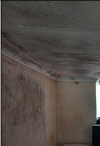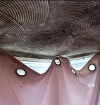Damp and Mould
What is condensation?
Condensation is the little droplets of water that you see on your windows on a cold morning or the mist on mirrors or cold surfaces such as tiles or walls when you have a bath or shower.
This is the most common cause of damp and mould.
The condensation season runs from October through to May.
Condensation doesn't just happen on windows or in the bathroom though - it can form on any cold surface in your home, such as near windows, in corners, and behind wardrobes and cupboards for example. You can usually tell if your damp is condensation as it does not leave a tidemark around the edges of the damp patch. If there is a 'tidemark' this dampness might have another cause, such as water leaking into your home from a plumbing fault, loose roof tiles or rising damp.
Common signs of damp inside a house are:
- damp and musty smell
- the appearance of mould or mildew on walls, floors or ceilings
- walls, floors or ceilings that feel cold or damp
- dark or discoloured patches on walls or plaster
- lifting or peeling wallpaper
- excessive condensation on windows
The images are from a small one bedroomed house. Due to an overcrowding situation the humidity levels were high and the low-level background ventilation, and rapid mechanical extraction was poor. This resulted in mould growth and dampness throughout the dwelling
The Centre for Sustainable Energy (CSE) website has further images on the types of damage that is caused by damp and condensation and has further useful information on how to treat and prevent it.
Visit the Centre for Sustainable Energy website for further information. (opens new window)







